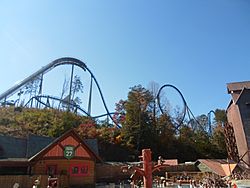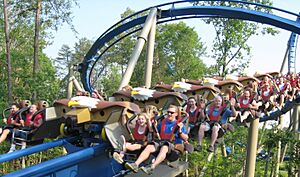Wild Eagle facts for kids
Quick facts for kids Wild Eagle |
|
|---|---|

Part of Wild Eagle's layout
|
|
| Dollywood | |
| Location | Dollywood |
| Park section | Wilderness Pass |
| Coordinates | 35°47′41″N 83°31′48″W / 35.794675°N 83.530127°W |
| Status | Operating |
| Soft opening date | March 23, 2012 |
| Opening date | March 24, 2012 |
| Cost | $20,000,000 ($25.5 million in 2022 dollars ) |
| General statistics | |
| Type | Steel – Wing Coaster |
| Manufacturer | Bolliger & Mabillard |
| Model | Wing Coaster |
| Lift/launch system | Chain lift hill |
| Height | 210 ft (64 m) |
| Drop | 135 ft (41 m) |
| Length | 3,127 ft (953 m) |
| Speed | 61 mph (98 km/h) |
| Inversions | 4 |
| Duration | 2:22 |
| Height restriction | 50–78 in (127–198 cm) |
| Trains | 2 trains with 7 cars. Riders are arranged 4 across in a single row for a total of 28 riders per train. |
|
TimeSaver Pass available
|
|
|
|
|
| Wild Eagle at RCDB | |
Wild Eagle is an exciting Wing Coaster at the Dollywood amusement park in Pigeon Forge, Tennessee. It was the very first roller coaster of its kind in the United States. Wild Eagle first opened to the media on March 23, 2012, and then to everyone else on March 24, 2012. This awesome ride reaches a height of 210 feet (64 m) and zooms up to speeds of 61 miles per hour (98 km/h). In September 2012, it was even named the "best new ride" of the year!
History of Wild Eagle
People started guessing about a new big ride at Dollywood in March 2011. Plans for a new attraction were sent to the city for approval. On March 24, 2011, these plans were given the green light. Even though city officials couldn't say exactly what it was, many thought it looked like a new roller coaster.
On September 4, 2011, Wild Eagle was officially announced! It was going to be the first wing coaster in the United States. By October 7, 2011, the tall lift hill was finished. The entire track was completed by the end of October 2011.
On February 28, 2012, Dollywood showed off a cool steel sculpture of an eagle. This eagle had a huge wing span of 42 feet (13 m) and weighed 8,000 pounds (3,600 kg). It was placed right near the ride's entrance. Wild Eagle had a special opening for the media on March 23, 2012. It then officially opened to the public the very next day, on March 24, 2012.
Riding the Wild Eagle
...There's nothing above you and nothing below you. You can fly like an eagle.
When your ride begins, the train leaves the station and turns left. It then starts climbing the 210-foot (64 m) chain lift hill. Once you reach the very top, you drop down 135 feet (41 m), picking up speed to 61 mph (98 km/h)!
Next, the train goes into a 110-foot (34 m) vertical loop. After that, it turns slightly left into a zero-g roll. Here, you feel like you are floating, just like in space! Right after the roll, you zoom into an immelmann loop. The train then slows down a bit with a trim brake.
You then twist through a corkscrew. This is followed by a camelback hill, which gives you a fun feeling of "air-time." This is when you feel light as you go over the top of the hill. The train then makes a sharp left turn, then a sharp right turn. This leads you into the final brake run. After another set of brakes, you arrive back at the station. One ride on Wild Eagle lasts about 2 minutes and 22 seconds.
The Trains
Wild Eagle uses two special trains. Each train is open-air and made of steel and fiberglass. They have seven cars, and each car has four seats. Two seats are on each side of the track. This means 28 riders can go on the ride at once! Riders are held safely in place by flexible shoulder restraints and seat belts.
Because the seats are on the side of the track, a strong steel arm supports the "wings" of the train. The front of each car looks like an eagle with its wings spread wide. This really adds to the feeling of flying!
The Track
The steel track for Wild Eagle is 3,127 feet (953 m) long. The highest point, the lift hill, is about 210 feet (64 m) tall. The track is painted a bright blue, and the supports that hold it up are tan. The roller coaster uses both friction brakes and magnetic brakes. These help control the train's speed and bring it to a safe stop.


